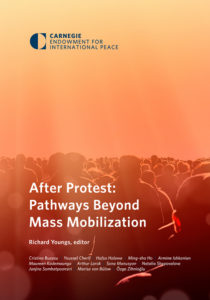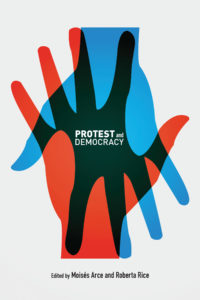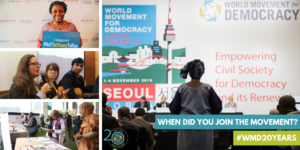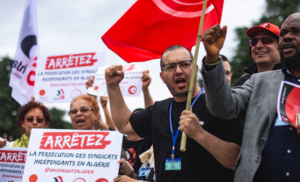“In a new study, we systematically examine how citizens have sought to promote democracy in about 150 countries. Here’s what we find: Industrial workers have been key agents of democratization and, if anything, are even more important than the urban middle classes. When industrial workers mobilize mass opposition against a dictatorship, democratization is very likely to follow,” they write for the Washington Post’s Monkey Cage blog:
Democratization is much more likely to follow mass protest movements that are dominated by the urban middle classes — and even more so when industrial workers are protesting. These groups often combine a strong preference for democracy (especially in urbanized societies) with the capacity to push through democratizing changes.
 Industrial workers, in particular, can use unions, international labor networks and social democratic parties to coordinate powerful challenges against dictatorial regimes. Here, we agree with influential, in-depth studies of specific European and Latin American countries, which highlight the historical role of labor movements in pushing for universal suffrage and competitive multiparty elections.
Industrial workers, in particular, can use unions, international labor networks and social democratic parties to coordinate powerful challenges against dictatorial regimes. Here, we agree with influential, in-depth studies of specific European and Latin American countries, which highlight the historical role of labor movements in pushing for universal suffrage and competitive multiparty elections.
The findings echo the claims of other research – such as Paths toward Democracy: The Working Class and Elites in Western Europe and South America – that analysts of democratic transitions have unduly emphasized elite-driven democratization, including the role of civil society groups.
Dramatic mass pro-democracy protests attract significant attention, but subsequent developments are just as vital for achieving sustainable change, a new analysis suggests.
A startling wave of large-scale citizen protests has washed over the political life of every region of the world, Carnegie’s Richard Youngs observes. As mass mobilization has become a pivotal aspect of global political struggle, After Protest: Pathways Beyond Mass Mobilization examines what happens when protests abate, addressing three specific elements across ten countries: how to categorize activists’ preferred pathways beyond protest, why activists choose these pathways, and how to understand the different outcomes.
 Spanning four regions, countries including Armenia, Egypt, Ethiopia, Romania, Thailand, Taiwan, Turkey, Ukraine, and Zimbabwe, and a timespan from 2013 to 2019, the analysis highlights a number of specificities unique to each country, but certain general trends transcend the nine cases,** notes Youssef Cherif, the deputy director of Columbia Global Centers, Tunis, and a member of Carnegie’s Civic Research Network:
Spanning four regions, countries including Armenia, Egypt, Ethiopia, Romania, Thailand, Taiwan, Turkey, Ukraine, and Zimbabwe, and a timespan from 2013 to 2019, the analysis highlights a number of specificities unique to each country, but certain general trends transcend the nine cases,** notes Youssef Cherif, the deputy director of Columbia Global Centers, Tunis, and a member of Carnegie’s Civic Research Network:
- One of these trends is the move into mainstream politics. The authors therefore asked: under what conditions do activists take such a route? Often the choice to join government or a governing coalition in parliament can lead to the continuation of effective activism, mainly where protests have been relatively successful. There, activists can work from inside the system and implement what they fought for, helping to build democracy. They channel their energy toward concrete political actions and transform street activism into mainstream politics. In Taiwan, for instance, after the successful 2014 revolt, many Sunflower movement activists entered formal politics. In Ukraine as well, after 2014, a number of Euromaidan activists joined the government…
- However, the case studies reveal that entering the sphere of power, even if it is a regime that emerges out of successful protests, can lead to cooptation. This is seen as a failure of the ideals for which activists rose up in the first place. In fact, when they reach power, revolutionary forces usually mutate into ruling machines, and the bureaucratic political system ends up prevailing over idealism….
 Another post-protest pathway relates to those who also entered politics but from an opposition angle. The nine case studies show that many activists either joined traditional political groups or created new ones—though the latter was more common. Activists who launched new movements proved that they can take their capacity to organize and lead civil society into politics. Their new movements are meant to break with established norms and be autonomous in applying their ideas and vision. Such models were seen in Taiwan, where democratic life continues to make gains and where new opposition groups were able to enter parliament through elections. In Thailand and Zimbabwe, where democracy is in tatters, some activists also moved into opposition politics.
Another post-protest pathway relates to those who also entered politics but from an opposition angle. The nine case studies show that many activists either joined traditional political groups or created new ones—though the latter was more common. Activists who launched new movements proved that they can take their capacity to organize and lead civil society into politics. Their new movements are meant to break with established norms and be autonomous in applying their ideas and vision. Such models were seen in Taiwan, where democratic life continues to make gains and where new opposition groups were able to enter parliament through elections. In Thailand and Zimbabwe, where democracy is in tatters, some activists also moved into opposition politics.- In some instances, activists refused categorically to enter politics and continued to be involved in activism from outside the system. In Armenia, for example, fear of cooptation kept many activists, especially the leftists opposing neoliberal policies, out of politics. They thus focused their efforts on opposing tax reforms and defending the working class, among other things, often in opposition to the new government. Yet they did not cut ties with their former colleagues who decided to join the government, and this allowed for channels of dialogue between the two sides. In the case of Ukraine, however, where the weakness of the central state has worsened the security situation and encouraged violent groups to form, many activists resorted to radical, violent means to apply pressure on the government, adopting a far-right ideology.
 One final postprotest trajectory is more disconcerting for the fate of global activism: in the wake of failed protests, many activists have abandoned activism or at least gone into prolonged hibernation. They feel resigned to this option for a number of reasons. Governments often restrict public space after protests, which makes activism risky. Activists may sense that they have achieved enough through protests, even though such judgment normally proves premature; conversely, they may feel despair if the outcome of protesting is negligible or even counterproductive. The leaderless nature of many protest movements also makes sustained activism difficult to achieve. Hibernation usually denotes a failure of the protest movement. RTWT
One final postprotest trajectory is more disconcerting for the fate of global activism: in the wake of failed protests, many activists have abandoned activism or at least gone into prolonged hibernation. They feel resigned to this option for a number of reasons. Governments often restrict public space after protests, which makes activism risky. Activists may sense that they have achieved enough through protests, even though such judgment normally proves premature; conversely, they may feel despair if the outcome of protesting is negligible or even counterproductive. The leaderless nature of many protest movements also makes sustained activism difficult to achieve. Hibernation usually denotes a failure of the protest movement. RTWT
*Sirianne Dahlum is a senior researcher at the Peace Research Institute Oslo and an International Security Program postdoctoral fellow at the Belfer Center, Harvard Kennedy School. Carl Henrik Knutsen is a professor of political science at the University of Oslo. Tore Wig is an associate professor of political science at the University of Oslo.
**Cases:
- Egypt After the 2011 Revolution: Divisions in Post-protest Pathways
- The Legacy of the Gezi Protests in Turkey
- The Postprotest Context in Armenia: Divergent Pathways for Civic Actors
- From the Square to Politics After Ukraine’s Euromaidan Protests
- After Protest: Pathways Beyond Mass Mobilization in Romania
- Civic Activism in the Post-Mugabe Era
- Modified Activism After Ethiopia’s New Dawn
- Postprotest Pathways in Thailand: Between the Street and the Ballots
- The Road to Mainstream Politics: How Taiwan’s Sunflower Movement Activists Became Politicians
Pathways After Protests: The Case of Brazil








